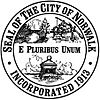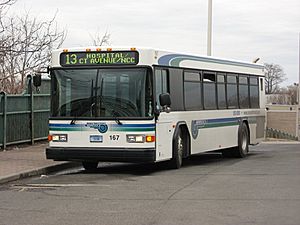Norwalk, Connecticut facts for kids
Quick facts for kids
Norwalk
|
|||||
|---|---|---|---|---|---|
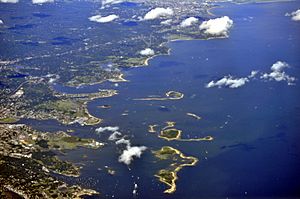
Aerial view of Norwalk Harbor and vicinity
|
|||||
|
|||||
| Etymology: Mohegan-Pequot language | |||||
| Nickname(s):
Oyster Town
|
|||||
| Motto(s):
Latin: E Pluribus Unum
|
|||||
 Fairfield County and Connecticut Fairfield County and Connecticut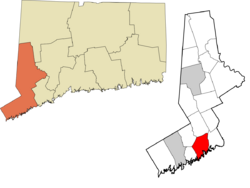 Western Connecticut Planning Region and Connecticut Western Connecticut Planning Region and Connecticut |
|||||
| Country | United States | ||||
| U.S. state | Connecticut | ||||
| County | Fairfield | ||||
| Region | Western CT | ||||
| Settled | February 26, 1640 | ||||
| Incorporated | September 11, 1651 | ||||
| Consolidated | June 6, 1913 | ||||
| Founded by | Roger Ludlow and Daniel Patrick | ||||
| Government | |||||
| • Type | Weak mayor–council | ||||
| Area | |||||
| • Total | 36.37 sq mi (94.20 km2) | ||||
| • Land | 22.89 sq mi (59.28 km2) | ||||
| • Water | 13.49 sq mi (34.93 km2) | ||||
| Elevation | 43 ft (13 m) | ||||
| Population
(2020)
|
|||||
| • Total | 91,184 | ||||
| • Estimate
(2024)
|
93,567 | ||||
| • Density | 3,983.574/sq mi (1,538.192/km2) | ||||
| Time zone | UTC−5 (Eastern Standard Time (EST)) | ||||
| • Summer (DST) | UTC−4 (Eastern Daylight Time (EDT)) | ||||
| ZIP Codes |
06850–06860
|
||||
| Area codes | 203/475 | ||||
| FIPS code | 09-55990 | ||||
| GNIS feature ID | 0209405 | ||||
| Major highways | |||||
| Commuter Rail | |||||
Norwalk is a city located in Fairfield County, Connecticut, USA. It's part of the larger New York City area and is the sixth-biggest city in Connecticut. In 2020, about 91,184 people lived there.
Norwalk sits on the northern shore of the Long Island Sound. It was first settled in 1649. The city is one of 18 towns and cities that make up the Western Connecticut Planning Region.
Contents
History of Norwalk
Norwalk has a long and interesting history!
Early Settlement and Name Origins
In 1640, Roger Ludlow bought the land east of the Norwalk River. He bought it from Chief Mahackemo of the Norwaake (or Naramauke) Indians. Norwalk was settled in 1649 and officially became a town in September 1651.
The city's name likely comes from an Algonquin word, noyank. This word means "point of land." It might also come from the Native American name "Naramauke."
Key Events in Norwalk's Past
During the American Revolutionary War, the Battle of Norwalk took place. This battle led to most of the town being burned down. In 1836, the central part of the town became known as the borough of Norwalk.
A major event happened in 1853. The first train accident in the United States occurred over the Norwalk River. This was known as the Norwalk rail accident. For many years, Norwalk was an important stop for the New York, New Haven and Hartford Railroad. In 1910, the city of South Norwalk and the rest of the town combined to form the Norwalk we know today.
In 1955, several hurricanes caused big floods in Norwalk Harbor. Later, in the 1970s, people worked to save old buildings in South Norwalk. This led to the creation of the Washington Street Historic District.
Geography of Norwalk
Norwalk covers about 36.3 square miles (94.2 square kilometers). About 13.5 square miles (34.9 square kilometers) of this area is water.
Norwalk's Neighborhoods
Norwalk has many different neighborhoods, each with its own feel. Some of these include:
- Broad River
- Brookside
- Central Norwalk
- Cranbury
- East Norwalk
- Golden Hill
- Hospital Hill
- Manresa Island
- Marvin Beach
- Oak Hills
- Rowayton
- Shorefront Park
- Silvermine
- South Norwalk
- Spring Hill
- Strawberry Hill
- Village Creek
- West Norwalk
- West Rocks
- Whistleville
- Wilson Point
- Wolfpit
Norwalk's Climate
Norwalk experiences a climate with warm summers and cold winters. Here's a look at the average temperatures and rainfall:
| Climate data for Norwalk, Connecticut | |||||||||||||
|---|---|---|---|---|---|---|---|---|---|---|---|---|---|
| Month | Jan | Feb | Mar | Apr | May | Jun | Jul | Aug | Sep | Oct | Nov | Dec | Year |
| Record high °F (°C) | 68 (20) |
71 (22) |
79 (26) |
95 (35) |
97 (36) |
97 (36) |
103 (39) |
97 (36) |
99 (37) |
89 (32) |
77 (25) |
66 (19) |
103 (39) |
| Mean daily maximum °F (°C) | 37 (3) |
39 (4) |
48 (9) |
60 (16) |
70 (21) |
79 (26) |
84 (29) |
82 (28) |
75 (24) |
64 (18) |
52 (11) |
42 (6) |
61 (16) |
| Daily mean °F (°C) | 28 (−2) |
31 (−1) |
40 (4) |
50 (10) |
60 (16) |
69 (21) |
74 (23) |
72 (22) |
64 (18) |
53 (12) |
43 (6) |
34 (1) |
52 (11) |
| Mean daily minimum °F (°C) | 19 (−7) |
21 (−6) |
29 (−2) |
38 (3) |
44 (7) |
57 (14) |
62 (17) |
61 (16) |
53 (12) |
40 (4) |
33 (1) |
24 (−4) |
40 (5) |
| Record low °F (°C) | −15 (−26) |
−7 (−22) |
−2 (−19) |
17 (−8) |
30 (−1) |
34 (1) |
45 (7) |
41 (5) |
31 (−1) |
17 (−8) |
14 (−10) |
−9 (−23) |
−15 (−26) |
| Average precipitation inches (mm) | 4.2 (110) |
3.15 (80) |
4.33 (110) |
4.37 (111) |
4.36 (111) |
3.94 (100) |
3.83 (97) |
3.89 (99) |
4.54 (115) |
3.89 (99) |
4.04 (103) |
3.96 (101) |
48.5 (1,236) |
| Average snowfall inches (cm) | 9.3 (24) |
8.3 (21) |
4.9 (12) |
.8 (2.0) |
0 (0) |
0 (0) |
0 (0) |
0 (0) |
0 (0) |
0 (0) |
.7 (1.8) |
4.6 (12) |
28.6 (72.8) |
| Average precipitation days | 10.5 | 9.7 | 10.9 | 12.5 | 12.5 | 11.7 | 10.2 | 9.7 | 9.8 | 9.2 | 10.6 | 11.3 | 128.6 |
| Average snowy days | 4.8 | 4.3 | 2.5 | .4 | 0 | 0 | 0 | 0 | 0 | 0 | .4 | 2.7 | 15.1 |
| Source 1: NCDC | |||||||||||||
| Source 2: The Weather Channel | |||||||||||||
Norwalk's Landscape
Norwalk's landscape is shaped by its coastline along Long Island Sound. The Norwalk River and its banks are also important features. The Norwalk Islands are another key part of the area. The highest point in Norwalk is 315 feet (96 meters) above sea level. This is found on the Silvermine Golf Course. The lowest point is sea level at Long Island Sound.
People of Norwalk: Demographics
| Historical population | |||
|---|---|---|---|
| Census | Pop. | %± | |
| 1790 | 11,942 | — | |
| 1800 | 5,146 | −56.9% | |
| 1810 | 2,983 | −42.0% | |
| 1820 | 3,004 | 0.7% | |
| 1830 | 3,972 | 32.2% | |
| 1840 | 3,863 | −2.7% | |
| 1850 | 4,651 | 20.4% | |
| 1860 | 7,852 | 68.8% | |
| 1870 | 12,119 | 54.3% | |
| 1880 | 13,956 | 15.2% | |
| 1890 | 17,747 | 27.2% | |
| 1900 | 19,932 | 12.3% | |
| 1910 | 24,211 | 21.5% | |
| 1920 | 27,743 | 14.6% | |
| 1930 | 36,019 | 29.8% | |
| 1940 | 39,849 | 10.6% | |
| 1950 | 49,460 | 24.1% | |
| 1960 | 67,775 | 37.0% | |
| 1970 | 79,288 | 17.0% | |
| 1980 | 77,767 | −1.9% | |
| 1990 | 78,331 | 0.7% | |
| 2000 | 82,951 | 5.9% | |
| 2010 | 85,603 | 3.2% | |
| 2020 | 91,184 | 6.5% | |
| 1790 population included Stamford and Greenwich. |
|||
Norwalk's Population in 2020
In 2020, Norwalk had a population of 91,184 people. The city is home to a diverse mix of people from different backgrounds.
| Race / Ethnicity (NH = Non-Hispanic) | Pop 2000 | Pop 2010 | Pop 2020 | % 2000 | % 2010 | % 2020 |
|---|---|---|---|---|---|---|
| White alone (NH) | 53,324 | 47,718 | 44,314 | 64.28% | 55.74% | 48.60% |
| Black or African American alone (NH) | 12,231 | 11,472 | 11,074 | 14.74% | 13.40% | 12.14% |
| Native American or Alaska Native alone (NH) | 95 | 94 | 102 | 0.11% | 0.11% | 0.11% |
| Asian alone (NH) | 2,672 | 4,045 | 4,772 | 3.22% | 4.73% | 5.23% |
| Pacific Islander alone (NH) | 28 | 25 | 14 | 0.03% | 0.03% | 0.02% |
| Some Other Race alone (NH) | 137 | 244 | 652 | 0.17% | 0.29% | 0.72% |
| Mixed Race or Multi-Racial (NH) | 1,498 | 1,235 | 2,627 | 1.81% | 1.44% | 2.88% |
| Hispanic or Latino (any race) | 12,966 | 20,770 | 27,629 | 15.63% | 24.26% | 30.30% |
| Total | 82,951 | 85,603 | 91,184 | 100.00% | 100.00% | 100.00% |
Norwalk's Population in 2010
In 2010, Norwalk had 85,603 people living in 35,415 households. About 27.9% of households had children under 18. The average household size was 2.55 people. The median age in the city was 40 years old.
The median income for a household was $76,161. For families, it was $103,032. About 8.4% of the population lived below the poverty line. This included 10.2% of those under 18.
Norwalk's Economy
Norwalk is home to many important companies. Some of these include:
- Booking Holdings
- Datto
- FactSet
- Pepperidge Farm
- Priceline.com
- Terex
- Ventus
- Xerox
The Financial Accounting Foundation and the Financial Accounting Standards Board are also based in Norwalk.
Arts and Culture in Norwalk
Norwalk offers many fun attractions and cultural experiences.
Popular Attractions
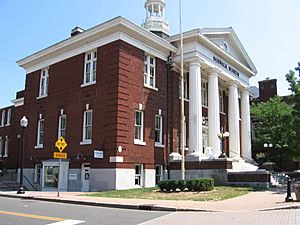
Some popular places to visit and events to enjoy in Norwalk are:
- Norwalk Oyster Festival
- Norwalk Boat Show
- Lockwood-Mathews Mansion Museum
- Maritime Aquarium at Norwalk
- The Mill Hill Historic Park and Museum
- Norwalk Film Festival
- Norwalk Historical Society Museum
- Norwalk Islands
- Norwalk Symphony Orchestra
- Norwalk Youth Symphony
- Sheffield Island Light (house)
- SoNo Switchtower Museum
- Stepping Stones Museum for Children
- National Havoc Robot League
Historic Sites to Explore
Norwalk has many sites listed on the National Register of Historic Places. These places are important for their history and architecture. Some of them are:
- Norwalk Green Historic District
- Joseph Loth Company Building
- Lockwood-Mathews Mansion
- Rock Ledge
- Norwalk's Former City Hall
- Sheffield Island Light
- Peck Ledge Lighthouse
- Greens Ledge Light
- Beth Israel Synagogue
- Village Creek
- White Barn Theatre
Education in Norwalk
Norwalk Public Schools runs the public schools in the city. There are also several private schools available.
Early Schools in Norwalk
Norwalk received its town charter from the Connecticut General Court in 1651. In 1678, town records show that the community decided to support teaching. They voted to hire a "scole master to teach all the children in ye town to lerne to Rede and write."
The first school was set up in the 1670s. It was located near the Ludlow Square area of East Norwalk.
Sports and Recreation
Norwalk is a great place for sports and outdoor activities!
Team Sports
Baseball and softball are very popular. Norwalk has many leagues for different age groups. There are four baseball fields and 16 Little League fields. Some fields, like those at Calf Pasture Beach, are lit up for night games.
The Norwalk Little League team even won the Little League World Series in 1952! In 2008, the 14-year-old Babe Ruth League team won their championship. The Norwalk Biddy Basketball All-Star team won state and regional titles in 1986. They then placed seventh in the world championships.
Water Sports and Activities
Since Norwalk is a coastal city, water sports are a big deal. You can find:
- Competitive swimming
- Recreational boating and fishing
- Sailing
- Windsurfing
- Kayaking
The Norwalk River and inner Norwalk Harbor are used for rowing events. Norwalk resident Daniel Walsh won a bronze medal in rowing at the 2008 Summer Olympics in Beijing.
Golf Courses
Norwalk has three golf courses:
- Shorehaven Golf Club (private, in East Norwalk)
- Silvermine Golf Club (private, part of it is in Wilton)
- Oak Hills Park golf course (public, in West Norwalk)
High School Sports Rivalries
There's a strong rivalry between the city's two biggest high schools: Norwalk High School and Brien McMahon High School. This is especially true for football, basketball, soccer, and field hockey in the fall. In the spring, the rivalry heats up for lacrosse, baseball, and softball.
Brien McMahon High School's football team won the Fairfield County Interscholastic Athletic Conference and Class M State Football championship in 1994. Their boys' lacrosse team won the state division 2 lacrosse championship in 2000.
Media in Norwalk
Norwalk has several sources for news and information.
News 12 Connecticut is a regional news channel based in Norwalk. It covers southwestern Connecticut. The Hour was a local daily newspaper founded in 1871. It was bought by Hearst Communications in 2016. NancyonNorwalk.com is a local news website that started in 2010.
Transportation in Norwalk
Norwalk has many ways to get around, from highways to trains.
Major Highways
Interstate 95 and the Merritt Parkway both pass through Norwalk. They are the main roads for traveling through the city. U.S. Route 1 also goes through the city center. The main north-south road is U.S. Route 7. This road is an expressway for most of its path in Norwalk. Other state routes include Routes 53, 123, and 136.
Bus Services
Public transport bus service in Norwalk is provided by Norwalk Transit District. They operate bus routes within Norwalk and Westport. They also have evening and Sunday shuttles. You can also take buses to other cities like Milford, Danbury, and Stamford. All fixed-route buses meet at the Transportation Hub.
Train Services
The Metro-North Railroad's New Haven Line runs through Norwalk and has stops here. Trains go west to Grand Central Terminal in New York City and east to New Haven Union Station. The Danbury Branch runs from South Norwalk to Danbury, CT.
Norwalk has four train stations:
- Rowayton
- South Norwalk
- East Norwalk
- Merritt 7 (on the Danbury Branch)
These stations provide commuter service for people traveling to and from work or school.
Nearby Airports
Norwalk is close to several airports, making travel easy.
| General Aviation Airports | Distance from Downtown Norwalk |
|---|---|
| Sikorsky Memorial Airport | 15 miles east in Stratford, Connecticut |
| Danbury Municipal Airport | 18 miles north in Danbury, Connecticut |
| Waterbury–Oxford Airport | 29 miles northeast in Oxford, Connecticut |
| Teterboro Airport | 38 miles southwest in Teterboro, New Jersey |
| Regional Airports | Distance from Downtown Norwalk |
|---|---|
| Westchester County Airport | 16 miles west in Westchester County, New York |
| Tweed New Haven Airport | 29 miles east in East Haven, Connecticut |
| International Airports | Distance from Downtown Norwalk |
|---|---|
| LaGuardia Airport | 34 miles southwest in Queens, New York |
| John F. Kennedy International Airport | 38 miles southwest in Queens, NY |
| Stewart International Airport | 45 miles northwest in Newburgh, New York |
| Newark Liberty International Airport | 50 miles southwest in Newark, New Jersey |
| Bradley International Airport | 68 miles northeast in Windsor Locks, Connecticut |
Norwalk's Infrastructure
Utilities and Services
Most of Norwalk gets its electricity and natural gas from Eversource Energy. However, some parts of the city have their own local power and water providers.
- The First Taxing District provides water to certain areas.
- The Second Taxing District, also known as South Norwalk Electric and Water (SNEW), serves parts of South Norwalk, East Norwalk, West Norwalk, Rowayton, and Silvermine. SNEW also owns and runs its own water system.
- The Third Taxing District provides electricity for East Norwalk.
These districts buy power in large amounts. This helps them get lower rates for their customers.
Emergency Services
Norwalk has dedicated teams to keep its residents safe. The Norwalk Police Department serves as the city's police department. The Norwalk Fire Department provides fire protection.
Norwalk Hospital and Norwalk Hospital EMS offer 24/7 emergency medical services. This includes 911 paramedic service. Their paramedics and EMTs serve Norwalk and nearby towns like New Canaan, Wilton, Weston, and Westport.
Notable People from Norwalk
Many interesting people have come from Norwalk! You can find a full list in the main article.
Sister Cities
Norwalk has two sister cities, which are cities that form a special bond to promote cultural ties and understanding:
- Nagarote, Nicaragua (since 1986) (see Norwalk/Nagarote Sister City Project)
- Riobamba, Ecuador (since 2018)
See also
 In Spanish: Norwalk (Connecticut) para niños
In Spanish: Norwalk (Connecticut) para niños



